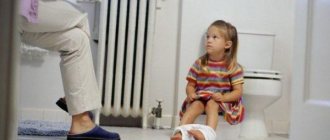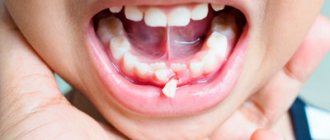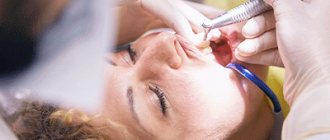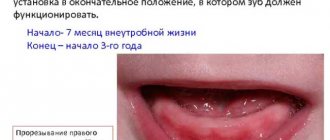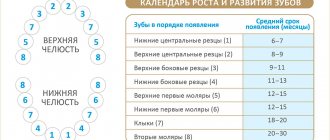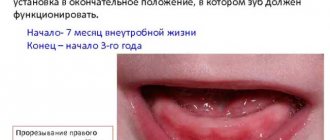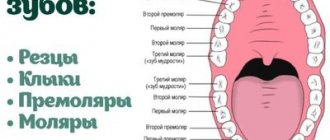What is edentia in children?
Adentia in children is a partial or complete absence of teeth due to their loss or abnormal development of the dental system. The disease is characterized by impaired chewing and speech function due to the lack of integrity of the dentition. In severe cases, dental edentia in children is accompanied by deformation of the facial skeleton and further loss of teeth. In the complete absence of teeth, there is often a displacement of the lower jaw towards the nose, retraction of the soft tissues of the pre-oral area, and the formation of wrinkles. With partial edentia in children, the remaining teeth shift and diverge. And in the process of chewing, an increased load falls on them.
Interesting fact!
The rudiments of baby teeth are formed in babies still in the womb, at about 3-4 months of pregnancy. The process of their formation takes about a month, so it is important that during this period the expectant mother consumes dairy products rich in calcium, without which the full formation and subsequent health of teeth is impossible.
Prevention of teething disorders in infants
Doctors recommend that women prepare in advance for the desired pregnancy. The expectant mother needs to closely monitor the health of her teeth and the condition of her oral cavity in general. It is useful to take vitamin complexes, as well as eat foods rich in calcium as often as possible.
It is recommended to get rid of bad habits and carefully monitor your health. It would be useful to regularly check the level of hemoglobin in the blood.
After the birth of the long-awaited baby, you need to monitor his proper nutrition, often walk in the fresh air, carry out hardening procedures and regular hygiene.
Types of edentia in children
Edentia in children is divided into types in accordance with the criteria indicated in the table below.
| Criterion | Type of edentia | Characteristic |
Time of occurrence | Primary (congenital) | Absence of baby teeth in young children and permanent teeth in older children |
| Secondary (acquired) | Lost tooth after eruption | |
Number of missing teeth | Partial | Some teeth are missing |
| Full | All teeth are missing | |
Age period | Edentia of temporary occlusion | Appears during the eruption of baby teeth |
| Edentia of permanent dentition | Appears during the period when baby teeth are replaced by permanent teeth. | |
Reason for missing tooth | True edentia | There is not even a tooth germ in the jaw |
| False edentia (retention) | Delayed tooth development. There is free space where the tooth should be, and subsequently it erupts |
Types of pathology
In dentistry, adentia is considered as a primary or secondary defect of the dentition.
- Complete congenital adentia is extremely rare, occurring in approximately 1% of cases.
- Partial secondary adentia is diagnosed in 45–75% of cases.
- Also, complete adentia occurs in 25% of people over 60 years of age.
Depending on the causes and time of occurrence of the pathology, dentists, as mentioned above, distinguish between congenital and secondary tooth loss, as well as edentia of temporary and permanent rows. True adentia is the absence of a tooth germ, and when adjacent crowns merge and there is a delay in their eruption, dentists speak of false adentia.
Taking into account the number of missing teeth, partial and complete edentia are distinguished. The first involves a deficiency of up to 10 units of dentition, usually the upper lateral incisors, second premolars and third molars. If more than 10 teeth are missing, doctors diagnose multiple adentia.
Ask a Question
Causes of edentia in children
Edentia in children can be hereditary, but it can also develop during the child’s life. In this regard, there are several causes of dental edentia in children.
- Absence or death of tooth buds.
This may be due to hereditary reasons, as well as disturbances in the formation of the fetus in the womb. A child’s dental plate is formed during the prenatal period, and exposure to harmful factors (for example, poor environment or an unhealthy lifestyle of the mother) can negatively affect this process. - Loss of teeth during life.
Children, especially boys, due to their activity, are more susceptible to injury than adults. Thus, children’s teeth often fall out during fights, falls, and also when playing certain sports (hockey, football, boxing). - Deep caries and its complications.
Due to the thin enamel of baby teeth, caries in children develops on them much faster than on permanent ones. Therefore, if it is not treated in a timely manner, there is a risk of losing the tooth as a result of progressive purulent-inflammatory processes in the tissues.
Why does an 8 month old baby have no teeth? Causes
There are many reasons why a baby may experience delayed teething. It is worth listing the most common ones.
1. Rickets. The occurrence of this disease can provoke a significant delay in teething. If the baby has been diagnosed with rickets, the baby’s parents need to go to a medical institution to conduct the necessary examination, as well as to donate blood to check for the presence of vitamin D in the baby’s body.
2. The presence of disorders in the endocrine system of the body.
3. The absence of teeth, caused by illnesses suffered by the mother during the period of bearing a child, can cause an eight-month-old child to have no teeth and severe disturbances in the order of their appearance.
The formation of the dental apparatus is also influenced by the diet followed by the expectant mother and lifestyle. The course of pregnancy is one of the factors that pediatricians consider when determining the cause of the delay in the appearance of the first teeth.
The delay in the appearance of hard formations in the infant’s oral cavity may be due to genetic characteristics. If close relatives: parents, sisters, brothers, grandparents, first teeth appeared quite late, then the phenomenon of delay is quite understandable.
Treatment of adentia in children
Diagnosis of dental adentia in children is carried out by visual and palpation examination, targeted intraoral radiography and orthopantomography. The treatment tactics for adentia in children are determined taking into account the physiological, anatomical and hygienic characteristics of the child’s dental system. Depending on the degree of the disease, the following methods of treating adentia in children are used.
- Stimulation of teething.
In some cases, a procedure is used to dissect the gums and install special braces that stimulate teething.
- Fixed prosthetics.
The child is fitted with permanent orthopedic structures (crowns, bridges).
- Removable prosthetics.
Removable orthopedic structures (clasp, plate dentures) are installed.
- Dental implantation.
It is used only after the jaw bones are completely formed. This process is usually completed at the age of 18 for boys and at 16-17 years for girls. Until this time, edentulous treatment is carried out using removable and fixed dentures.
How many teeth should an eight month old baby have?
Correct, i.e. normal, development of the baby’s chewing apparatus implies that the baby has the rudiments of 20 milk teeth and 16 molars. By the eighth month of a baby’s life, there may be from two to four teeth in the baby’s mouth. In some cases, the number of solid formations can reach six or even eight.
Teeth eruption is characterized by their paired appearance on the left and right sides of the jaw. Solid formations begin to appear in a certain sequence. However, here, too, some deviations from the norm are possible, due to the characteristic features of the child’s body or genetic characteristics.
Consequences of edentia in children
If you do not consult a specialist in time and do not treat edentia in children, this can lead to deformation of the facial skeleton, which results in developmental defects in the child.
- Speech impairment.
With complete or partial absence of teeth, the child pronounces some sounds incorrectly, and may even lose the ability to pronounce them. - Chewing dysfunction.
Due to a decrease in the quality of chewing food and changes in food consumption patterns, missing teeth often leads to gastrointestinal diseases in a child. - Mental disorders.
Missing teeth is also a cosmetic defect. The baby is embarrassed to smile, and as a result he develops complexes. In addition, disturbances in the functioning of the jaws caused by edentia bring discomfort and cause deterioration in mood.
Complications
Adentia leads to a variety of physical and aesthetic complications:
- in the area where a tooth is missing, the unloaded bone gradually atrophies;
- the face may become asymmetrical, lip closure is disrupted, and the chin and nasolabial folds deepen. Often the position of the corners of the mouth changes, they begin to sink;
- underdevelopment of the jaws occurs. It is expressed more strongly the more teeth are missing, various dentofacial deformations appear;
- with multiple edentia of the lower jaw, its strong protrusion and deep bite are observed;
- with anomalies of the upper jaw, the lower dentition begins to overlap the upper one;
Underdevelopment of the jaws is not observed in all cases, and not all children and adults express it in the same way. However, in all cases, edentia leads to negative changes in appearance.
With complete or multiple edentia, the bite is formed incorrectly and the function of oral digestion is disrupted. The food is poorly crushed, and the patient is forced to give up many tasty dishes. We should not forget that with this pathology a person’s self-esteem decreases, he begins to worry about the fact that he looks unattractive, withdraws into himself and is less likely to make contact with people.
How much does treatment cost?
Treatment of adentia in children begins with an initial examination and drawing up a treatment plan. Typically, these services are provided free of charge - as a promotion to attract customers. Also, a small patient will need to have an x-ray at a cost of 350 rubles and a panoramic photograph of the oral cavity, the cost of which starts at 1,000 rubles. In addition, before starting treatment of adentia in children, it is necessary to carry out professional oral hygiene at a price of 2,700 rubles and more. Based on the fact that edentia in children is treated primarily by installing removable dentures, parents should be prepared for the following costs for various types of orthopedic structures: a partially removable laminar denture costs from 1,750 to 60,000 rubles, a complete removable laminar denture costs from 40,000 to 100,000 rubles, temporary complete removable denture - from 2,800 to 3,500 rubles. A removable acrylic prosthesis will cost from 12,000 rubles, a bridge prosthesis - from 25,000 rubles. The cost usually includes the manufacture of the structure and its installation by a specialist.
When do the first teeth appear?
It is widely believed that a baby's first teeth should appear at six months.
If a child is 8 months old and has no teeth, parents begin to worry. Baby teeth begin to form in utero long before they become visible. Their rudiments appear already in the sixth week after fertilization. Over the next months, gradually, layer by layer, they are covered with hard enamel. A newborn's baby teeth are already formed.
A little later, roots begin to form. As they grow, they slowly push out the top of the tooth, which breaks through the gum. It happens that everything happens so quickly that the child is born with one or two teeth.
Newborn with teeth
The norm of the appearance of the first teeth
Usually, parents begin to look into the baby's mouth in search of the long-awaited tooth when he is 6 months old. Many of them soon find what they are looking for there. The rest patiently continue to carry out daily inspections. When a child turns 7 months old and still has no teeth, this is not a reason to worry. Most parents know this and therefore remain calm.
But when a baby doesn’t have a single tooth at 8 months, there is slight anxiety in the family. After all, everyone knows that from six to the beginning of the ninth month the incisor should appear. But should you? In fact, these norms are based on average statistics and are not a rule. There are cases when children are already born with several teeth, and it happens that the baby’s first incisor pecks only in the 9th or even 12th month of his extrauterine life.
Additional Information. In general, pediatricians advise parents not to panic if a long-awaited event drags on for up to 1.5 or even 2 years. Of course, provided that the rest of the baby develops normally.
Timing of the eruption process
There are average periods for the appearance of teeth, which are the norm.
Important! Each child is individual. It will be normal for a 4-month-old baby to erupt the first teeth and for a 10-month-old baby too.
Average terms:
- At birth, teeth are not visible. They are partially formed, but are located inside the gum;
- The first teeth appear on average between the fourth and seventh months (most often around 6 months of age). First, 4 central incisors emerge, two each below and above;
- At approximately seven or eight months, the 4 lateral incisors emerge;
- When a child is about a year old, his first 4 molars begin to grow. This leaves free space between them and the lateral incisors;
- This space contains 4 canines, which usually emerge at approximately 1 year and 4 months;
- At about 2 years of age, the second molars begin to grow;
- At the age of 3 years, a child should have all 20 baby teeth.
Teething pattern
Important! In children with late teething, they can all come out almost simultaneously.
Number of teeth at 8 months of age
For most children, the appearance of their first tooth becomes a pleasant surprise at the age of six months. Sometimes both lower incisors are shown at once. The upper central incisors erupt next. By the age of 8 months, the baby’s mouth is usually decorated with 4 teeth. And by one year – 8-12 teeth. All milk, namely 20 units, should appear by 3 years.
This is interesting: Flux of baby teeth on a child’s gum: what to do at home, treatment at the dentist

